Threadripper 9000 CPUs will revive the HEDT market on July 31, starting at $1,499 for 24 cores — the flagship 64-core chip will set you back $4,999
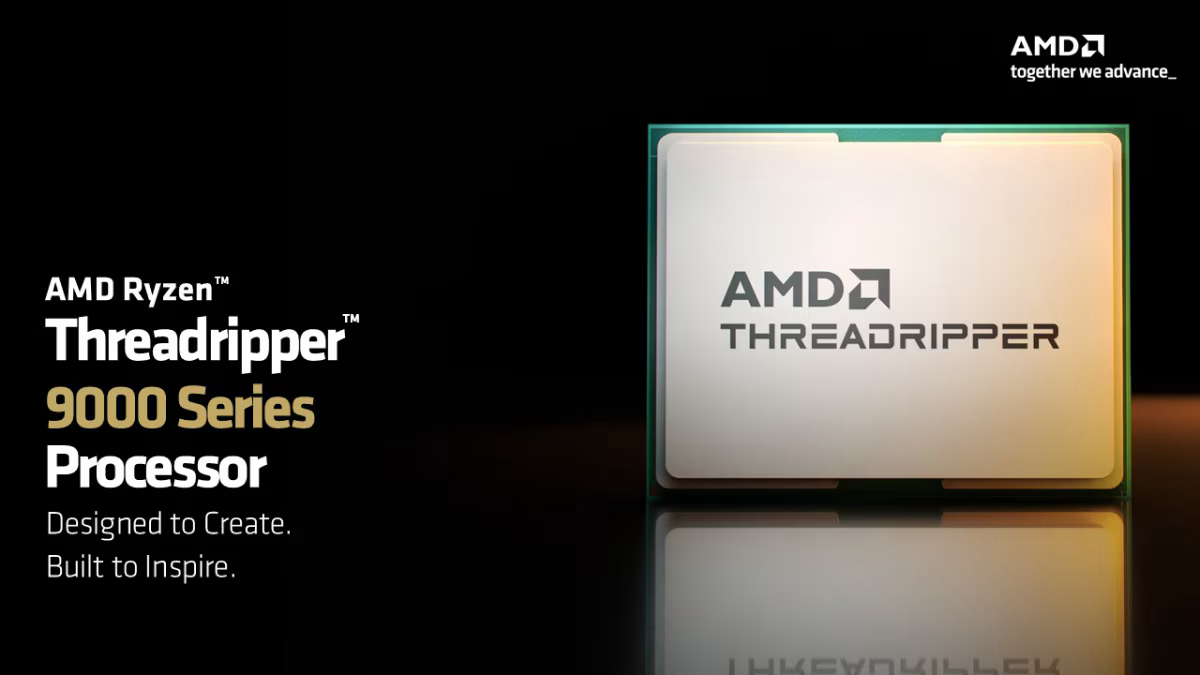
AMD has officially unveiled its Ryzen Threadripper 9000 series, a new wave of Zen 5-based high-end desktop (HEDT) processors, scheduled to launch on July 31. With up to 64 cores, 128 threads, and boost clocks peaking at 5.4 GHz, this lineup aims to push multi-core performance and memory bandwidth to new heights while maintaining the aggressive pricing of its predecessor, the Threadripper 7000 series. These SKUs were announced earlier this year and have leaked countless times, but we've finally reached the actual launch.
The 9000 series fills the space between AMD’s mainstream Ryzen chips and its recently introduced Threadripper PRO 9000 WX-series, but without the workstation price tags. These non-Pro SKUs are designed for enthusiasts, creators, and developers who demand extreme performance for rendering, video editing, AI workloads, and heavy multi-threaded tasks, but who don’t need the expanded feature set or octa-channel memory of the Pro platform. The standout detail is the pricing as it remains unchanged from the previous generation: the 64-core 9980X comes in at $4,999, the 32-core 9970X at $2,499, and the 24-core 9960X at $1,499.
Ryzen Threadripper 9000 Specifications and Pricing
CPU Model | Series | Cores / Threads | Base / Boost Clock | L3 Cache | Memory Support | PCIe Lanes | TDP | Price (USD) |
|---|---|---|---|---|---|---|---|---|
Threadripper 9980X | 9000 HEDT (Zen 5) | 64C / 128T | 3.2 / 5.4 GHz | 256 MB | Quad-channel DDR5-6400 (Up to 1TB) | Up to 80 PCIe 5.0 | 350W | $4,999 |
Threadripper 9970X | 9000 HEDT (Zen 5) | 32C / 64T | 4.0 / 5.4 GHz | 128 MB | Quad-channel DDR5-6400 | Up to 80 PCIe 5.0 | 350W | $2,499 |
Threadripper 9960X | 9000 HEDT (Zen 5) | 24C / 48T | 4.2 / 5.4 GHz | 128 MB | Quad-channel DDR5-6400 | Up to 80 PCIe 5.0 | 350W | $1,499 |
Threadripper PRO 9995WX | 9000 PRO (Zen 5) | 96C / 192T | 2.5 / 5.4 GHz | 384 MB | Octa-channel DDR5-6400 (Up to 2TB) | Up to 128 PCIe 5.0 | 350W | $11,699 |
Threadripper PRO 9985WX | 9000 PRO (Zen 5) | 64C / 128T | 3.2 / 5.4 GHz | 256 MB | Octa-channel DDR5-6400 | Up to 128 PCIe 5.0 | 350W | $7,999 |
Threadripper PRO 9975WX | 9000 PRO (Zen 5) | 32C / 64T | 4.0 / 5.4 GHz | 128 MB | Octa-channel DDR5-6400 | Up to 128 PCIe 5.0 | 350W | $4,099 |
Threadripper PRO 9965WX | 9000 PRO (Zen 5) | 24C / 48T | 4.2 / 5.4 GHz | 128 MB | Octa-channel DDR5-6400 | Up to 128 PCIe 5.0 | 350W | $2,899 |
Threadripper PRO 9955WX | 9000 PRO (Zen 5) | 16C / 32T | 4.5 / 5.4 GHz | 64 MB | Octa-channel DDR5-6400 | Up to 128 PCIe 5.0 | 350W | $1,649 |
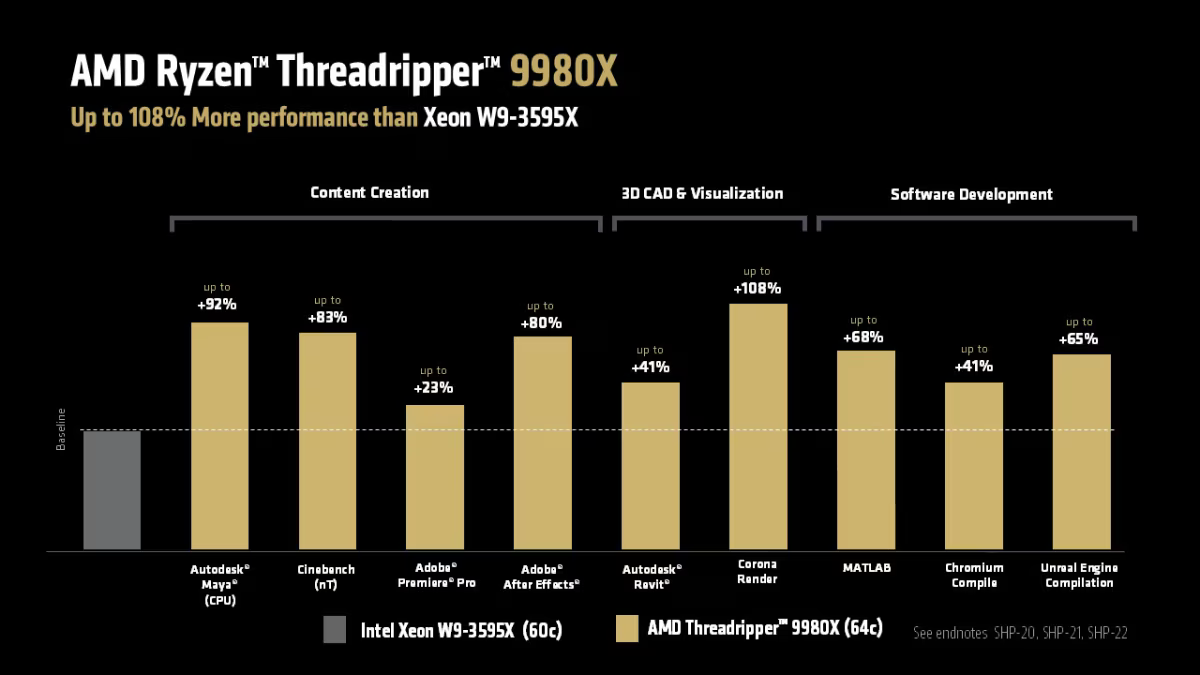
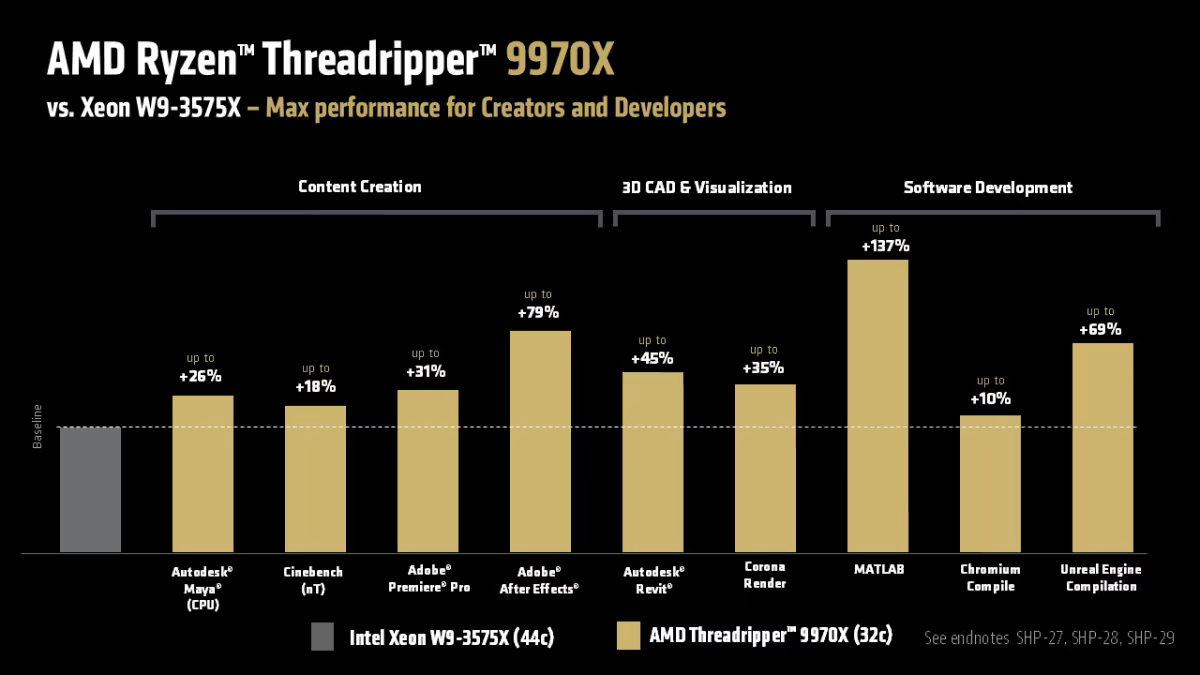
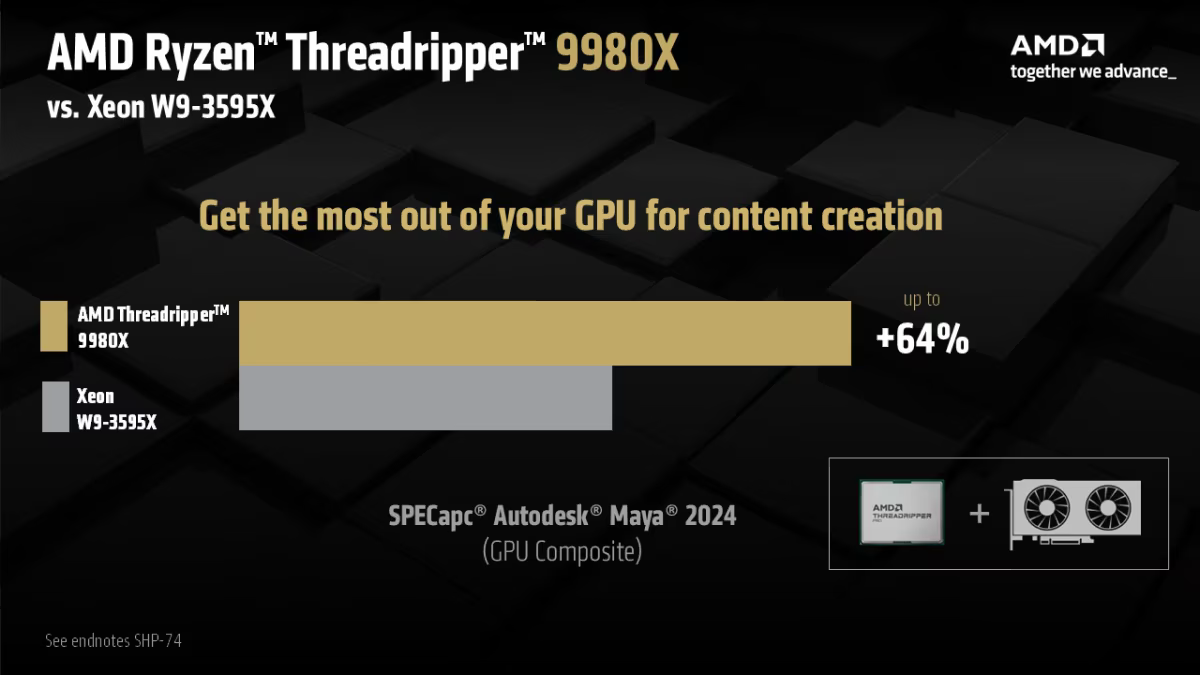
The lineup slots into AMD’s TRX50 platform, which supports 4-channel DDR5-6400 RDIMM memory and up to 80 PCIe 5.0 lanes (92 in total, with 8 PCIe 4.0 lanes). This combination gives creators access to double the memory bandwidth of mainstream desktop systems and ensures bandwidth headroom for modern GPUs and storage. Like its predecessor, overclocking remains supported out of the box.
Performance claims from AMD are bold; the flagship 9980X is said to deliver up to 108% better performance compared to Intel’s 60-core Xeon W9-3595X in compute-heavy workloads, while the 32-core 9970X offers 137% faster results against Intel’s 44-core Xeon W9-3575X. AMD also highlights significant gains in real-world creator benchmarks, such as Cinebench 2024 and Adobe After Effects, as well as AI inferencing and large-model processing, areas where multi-core throughput and PCIe bandwidth are crucial.
Each chip in the 9000 series packs a 350W TDP, but thanks to Zen 5’s refined architecture, efficiency and clock scaling have improved, with all SKUs capable of hitting 5.4 GHz boost clocks. There’s also full AVX-512 support with a 512-bit data path, a significant step up for workloads like scientific computing, AI, and video encoding.
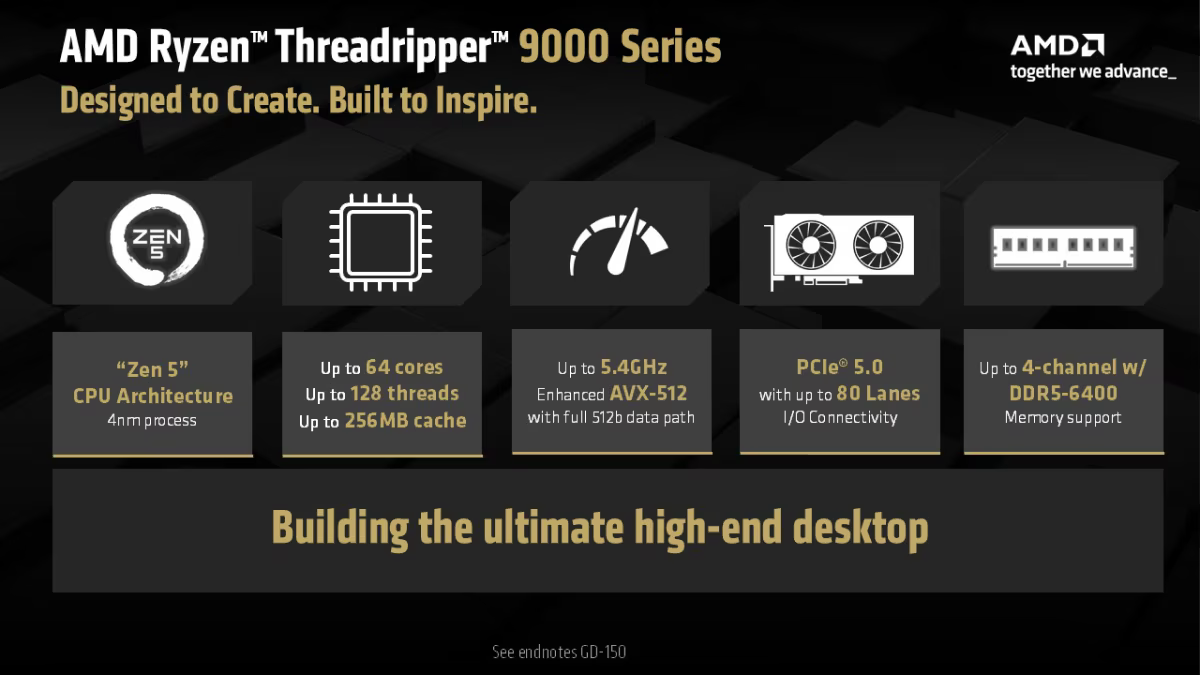
With the 9000 series, AMD is making a clear statement that HEDT isn’t dead, and Zen 5’s multi-core scaling ensures it’s more relevant than ever. Whether for AI developers requiring bandwidth for multi-GPU setups or creators demanding brute-force rendering performance, these chips aim to provide unmatched flexibility without entering the cost-prohibitive territory of the PRO line. AMD’s decision to hold prices steady while delivering architectural improvements and higher clock speeds is also a strong move against Intel’s Xeon W lineup, which continues to lag in raw performance per dollar.
This launch also rounds out AMD’s Zen 5 desktop portfolio, complementing the mainstream Ryzen 9000 CPUs with a high-end offering that targets professionals and enthusiasts alike. Together, the two families demonstrate how AMD is leveraging its architectural lead to dominate both consumer and professional desktop markets, with a bullish return for HEDT, offering more performance headroom while maintaining aggressive pricing.
Get Tom's Hardware's best news and in-depth reviews, straight to your inbox.
Follow Tom's Hardware on Google News to get our up-to-date news, analysis, and reviews in your feeds. Make sure to click the Follow button.

Hassam Nasir is a die-hard hardware enthusiast with years of experience as a tech editor and writer, focusing on detailed CPU comparisons and general hardware news. When he’s not working, you’ll find him bending tubes for his ever-evolving custom water-loop gaming rig or benchmarking the latest CPUs and GPUs just for fun.
-
Li Ken-un AMD’s offerings are looking better by the day. None of that Intel baloney with license activation for additional CPU features.Reply -
thestryker I've said it before and I'll say it again: these are not HEDT CPUs they're just two flavors of workstation. Base price of entry is ~2.3x the cost of 9950X MSRP (real world even bigger gap). The cheapest TRX50 board is ~$600 which is significantly higher than required to run the 9950X, but even pointing at a mid range X870E board is +$250. Then there's the memory 4x 16GB DDR5-6000 CL30 RDIMMs cost ~$450 whereas 2x 32GB DDR5-6000 CL30 UDIMMs cost ~$190.Reply
All combined that's a platform cost of entry which is over 2x the cost or simply you could buy the entire desktop platform for less than the cost of the lowest TR CPU alone. The cost alone is off putting, but the TR CPUs will also be slower than their desktop counterparts at anything that can't take advantage of increased memory bandwidth and/or core counts. These things combine to push TR into workstation category where it belongs. HEDT is dead and pretending otherwise is a disservice. -
txfeinbergs If you say so (multiple times by your own admission). I consider my RTX 5090 and soon to be 9950X3D more than HEDT enough. Definitely not dead.Reply -
jlake3 Reply
What exactly IS the definition of "HEDT" anyway, if not a light version of the workstation platform?thestryker said:I've said it before and I'll say it again: these are not HEDT CPUs they're just two flavors of workstation. Base price of entry is ~2.3x the cost of 9950X MSRP (real world even bigger gap). The cheapest TRX50 board is ~$600 which is significantly higher than required to run the 9950X, but even pointing at a mid range X870E board is +$250. Then there's the memory 4x 16GB DDR5-6000 CL30 RDIMMs cost ~$450 whereas 2x 32GB DDR5-6000 CL30 UDIMMs cost ~$190.
All combined that's a platform cost of entry which is over 2x the cost or simply you could buy the entire desktop platform for less than the cost of the lowest TR CPU alone. The cost alone is off putting, but the TR CPUs will also be slower than their desktop counterparts at anything that can't take advantage of increased memory bandwidth and/or core counts. These things combine to push TR into workstation category where it belongs. HEDT is dead and pretending otherwise is a disservice.
I remember wanting an X99 system back in the day, but those carried off-putting premiums unless you really needed the memory bandwidth/capacity, additional PCIe lanes, or core counts. Motherboards were more expensive, the processors were more expensive (especially for the ones people actually wanted), and you needed quad-channel memory to get the most out of them. Single core boost they were on par with the mainstream chip, if I remember correctly, but their all-core clocks were generally much slower than the mainstream counterparts and they did sometimes lose in certain tasks to the top i7s.
The gap between mainstream and HEDT/workstation has gotten bigger as mainstream core counts and PCIe lane counts increased, but the low end of HEDT was always a hard sell and poor value unless you had very particular requirements, and the high end of HEDT was always irrational for gaming but a discount versus similar spec workstations. -
thestryker Reply
HEDT was birthed as a higher performance alternative to desktop processors. Actual features were removed (like ECC, enterprise features and memory capacity) from workstation platforms and the prices were dropped significantly because of it (typically ~30% minimum).jlake3 said:What exactly IS the definition of "HEDT" anyway, if not a light version of the workstation platform?
Processors cost ~20% more at the entry level for 50% more cores (aside from those hilarious Skylake-X quad cores which I still don't quite understand).jlake3 said:I remember wanting an X99 system back in the day, but those carried off-putting premiums unless you really needed the memory bandwidth/capacity, additional PCIe lanes, or core counts. Motherboards were more expensive, the processors were more expensive (especially for the ones people actually wanted), and you needed quad-channel memory to get the most out of them. Single core boost they were on par with the mainstream chip, if I remember correctly, but their all-core clocks were generally much slower than the mainstream counterparts and they did sometimes lose in certain tasks to the top i7s.
The motherboards could certainly cost more, but at that time SLI was still a thing and they didn't require switches so that put it into a different position (50% more cost was certainly possible if you didn't care about SLI support comparing the two). By the time desktop core counts started to increase the HEDT motherboards didn't carry as much of a price premium because desktop boards started getting more expensive in general while HEDT didn't change.
Quad channel memory didn't necessarily cost more when comparing equal capacity so that doesn't particularly enter into the equation since it was a matter of buying 4x 4GB sticks instead of 2x 8GB (or 4x 8GB vs 2x 16GB of course). HEDT all core clocks were fine it was the boost clocks (TB 3.0 and whatnot) that were generally behind without overclocking.
Lane counts on desktop haven't changed since SNB only chipset connectivity has.jlake3 said:PCIe lane counts increased
Promise you anyone who bought a 6700K/7700K were having a lot more problems than anyone using a 6800K over time (even without overclocking). If you're replacing your system every generation or two I certainly agree with you here though.jlake3 said:the low end of HEDT was always a hard sell and poor value unless you had very particular requirements
This right here is the reason I say HEDT doesn't exist anymore, because previously it filled a gap in the market. Until AMD released the 1700X you couldn't get more than 4 cores in a desktop platform. At the very least Skylake should have been 6 or 8 cores as that's when workloads getting more parallelized was really becoming common. Of course Intel was also playing HT games until 10th Gen which didn't particularly help things.jlake3 said:The gap between mainstream and HEDT/workstation has gotten bigger as mainstream core counts
AMD's first Threadripper CPUs (Zen/Zen+ era) undercut Intel HEDT slightly and had more PCIe lanes, but didn't officially support ECC memory (I think it was like Ryzen and if the motherboard enabled it then it worked). Once they shifted to the 3000 series Threadripper became full workstation priced with no desktop core count overlap (Pro did overlap, but the price premium there is obviously massive as you're buying specifically for the memory and/or lane count). -
-Fran- Reply
Sorry, but I have to disagree with all your premises in here.thestryker said:HEDT was birthed as a higher performance alternative to desktop processors. Actual features were removed (like ECC, enterprise features and memory capacity) from workstation platforms and the prices were dropped significantly because of it (typically ~30% minimum).
Processors cost ~20% more at the entry level for 50% more cores (aside from those hilarious Skylake-X quad cores which I still don't quite understand).
The motherboards could certainly cost more, but at that time SLI was still a thing and they didn't require switches so that put it into a different position (50% more cost was certainly possible if you didn't care about SLI support comparing the two). By the time desktop core counts started to increase the HEDT motherboards didn't carry as much of a price premium because desktop boards started getting more expensive in general while HEDT didn't change.
Quad channel memory didn't necessarily cost more when comparing equal capacity so that doesn't particularly enter into the equation since it was a matter of buying 4x 4GB sticks instead of 2x 8GB (or 4x 8GB vs 2x 16GB of course). HEDT all core clocks were fine it was the boost clocks (TB 3.0 and whatnot) that were generally behind without overclocking.
Lane counts on desktop haven't changed since SNB only chipset connectivity has.
Promise you anyone who bought a 6700K/7700K were having a lot more problems than anyone using a 6800K over time (even without overclocking). If you're replacing your system every generation or two I certainly agree with you here though.
This right here is the reason I say HEDT doesn't exist anymore, because previously it filled a gap in the market. Until AMD released the 1700X you couldn't get more than 4 cores in a desktop platform. At the very least Skylake should have been 6 or 8 cores as that's when workloads getting more parallelized was really becoming common. Of course Intel was also playing HT games until 10th Gen which didn't particularly help things.
AMD's first Threadripper CPUs (Zen/Zen+ era) undercut Intel HEDT slightly and had more PCIe lanes, but didn't officially support ECC memory (I think it was like Ryzen and if the motherboard enabled it then it worked). Once they shifted to the 3000 series Threadripper became full workstation priced with no desktop core count overlap (Pro did overlap, but the price premium there is obviously massive as you're buying specifically for the memory and/or lane count).
AMD has supported ECC in all Zen models as long as the motherboard vendor includes support for the sticks. The PCIe lanes have been increasing, but at a painfully slow pace, limiting the usability of I/O and PCIe X16 options. AMD, in particular, has been really lazy on the chipset I/O design department.
And HEDT is just "high end desktop", which you can take/interpret it any way you want, really. Historically, just to keep it in perspective, consumer and server CPUs (and platforms) had very little differences, mostly due to technology maturing and prices still being rather high on both ends. Nowadays, the gap between Workstation/Server and Consumer is just artificial segmentation thanks to Intel and AMD following suit. I still remember consumer grade dual socket motherboards for Pentium 2 and 3. Not cheap, but it wasn't that much more than a linear increase in price.
Should Threadripper start at 1.5K? No, I don't think so. Is it HEDT? Absolutely.
The cost is stupid high now due to the niche it covers and how little competition is in the space. We're long overdue to make tri or quad channel belong in consumer. Same with ECC to be "standard". More lanes and all of that. The increases in bandwidth demand on consumer platforms has gone quite high, but how can you tell people "those 16 cores are starved" or "your disk performance would be better if you had more lanes" and so on. There's no comparison point for a consumer platform to grow outside of just CPU performance because it's hella hard to compare within the same price range (this goes back to the artificial segmentation part).
So, in short: Threadripper is indeed HEDT, as much as it is Workstation. It's just AMD squeezing money from the platform because niche and dominance.
Regards. -
DonQuixoteIII At some point in time (probably the point when hell freezes...) CPU's and motherboards will stop being two-tiered. There is really no real reason (logicly) for the lack of ECC or PCIe lanes on DT boards right now, except that there is more PROFIT MARGIN on the HEDT versions. Charge what the market will bear, is the saying, right? Or, greed is good....Reply -
Notton IMO HEDT and Desktops are in a weird spot.Reply
At the low end to mid range, you have MoDT that are perfectly capable while costing significantly less.
In the mid range, you have a nice 9800X3D for gaming, but memory bandwidth starved APU lineup.
With HEDT you get memory bandwidth and PCIe lanes but no APU to benefit from the memory bandwidth, and a platform that is far too costly.
And now we have Strix Halo which is a good attempt at the APU memory bandwidth problem, but it's still costly.
The way I see it, most of these problems can be solved if there was a cheap PCIe 5.0 to 4.0 switch. -
jkhoward If the Zen 6 rumors are true, you’re better off waiting for the 9950X3D equivalent with 24 cores, and more cache.Reply